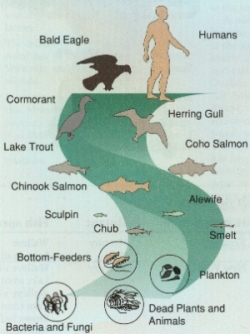


Water pollution

It is easy to dispose of waste by dumping it into a river or lake. In large or small amounts, dumped intentionally or accidentally, it may be carried away by the current, but will never disappear. It will reappear downstream, sometimes in changed form, or just diluted. Freshwater bodies have a great ability to break down some waste materials, but not in the quantities discarded by today's society. This overload that results, called pollution, enventually puts the ecosystem out of balance.
Sometimes nature itself can produce these imbalances. In some cases, the natural composition of the water makes it unfit for certain uses: e.g., water flowing in the highly saline terrain of the prairies or gushing from highly mineralized springs in some parts of the country cannot sustain fish populations.
But most often our waterways are being polluted by municipal, agricultural and industrial wastes, including many toxic synthetic chemicals which cannot be broken down at all by natural processes. Even in tiny amounts, some of these substances can cause serious harm.
What Causes Water Pollution?
The quality of Canada's freshwater and marine areas is affected by three important water pollution problems: toxic substances, excess nutrients, and sedimentation.
Toxic substances from industrial, agricultural and domestic use are some of the main pollutants in our water. These include trace elements, polychlorinated biphenyls (PCBs), mercury, petroleum hydrocarbons, dioxins, furans and some pesticides. Some of these substances accumulate through the food chain rather than break down in the environment.
These substances enter our water in a variety of ways, including:
- industrial sources such as mining, steel production, the generation of electricity and chemical production;
- accidents such as oil or chemical spills and contaminated sites such as the Sydney Tar Ponds in Nova Scotia;
municipal wastewater effluents; Atmospheric deposition from Mexico, the United States, Europe and Asia, which is deposited in Canada through rain and snow; and agricultural run-off. Toxic substances in the food chain

Excess nutrients such as nitrogen and phosphorous compounds come mainly from municipal sewage and farm run-off containing fertilizers and animal waste. These nutrients can cause excess growth of aquatic plants, which then die and decay, depleting water of dissolved oxygen and killing fish.
Sedimentation is an increase in the amount of solid particles in water, caused primarily by human activities such as forestry, farming and construction. When sediment settles, it can smother the feeding and spawning grounds of fish and kill aquatic organisms.
Why Should We Be Concerned?
Water pollution has wide-ranging impacts on our health, our environment and our economy. Some toxic substances in our water are known to cause cancer. Others are harmful to reproductive and immune systems and have been detected in the breast milk of mothers. Toxic substances in acid rain are also damaging to our environment.
Water pollution will eventually reduce the value of water to industry and makes it more expensive to treat for household use.
